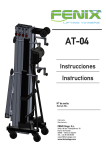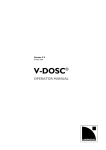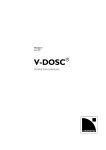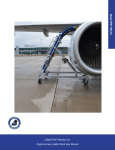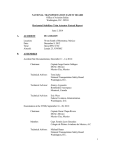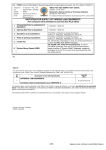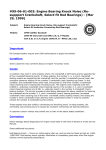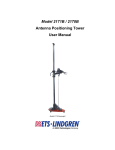Download Operator Manual
Transcript
UL25, UL32 & UL40 SERIAL NUMBERS 15001 TO CURRENT WARNING All personnel shall carefully read, understand and follow all safety rules, operating instructions and the Scaffold Industry Association's MANUAL OF RESPONSIBILITIES before performing maintenance on or operating any UpRight aerial work platform. SAFETY RULES NEVER elevate platform unless all four (4) outriggers have been properly installed. All outrigger screwjack pads must be in solid contact with a firm surface before the platform is elevated. NEVER operate the machine within ten feet of power lines. THIS MACHINE IS NOT INSULATED. NEVER attempt to move the UpRight Lift with people or materials on the platform or with the platform elevated. NEVER sit, climb, or stand on the platform guardrails or midrail. NEVER elevate platform without first leveling the base. NEVER use ladders, planks or other devices to increase the height of the platform. NEVER attach overhanging loads to the platform or increase the platform size. NEVER elevate the platform if it contains more than one person or more than the rated load (see specifications on back page). LOOK up, down and around for overhead obstructions and electrical conductors. NEVER change operating or safety systems. NEVER use outriggers from one model on another model. CLOSE and secure cage after entering platform. INSPECT the machine thoroughly for cracked welds, loose or missing hardware, hydraulic leaks, damaged control or power cables and loose wire connections. NEVER use the machine as a freight or personnel elevator. NEVER recharge battery near sparks or open flame; batteries that are being charged emit highly explosive hydrogen gas. AFTER USE secure the work platform against unauthorized use by turning key switch off and removing key. NEVER replace any component or part with anything other than original UpRight replacement parts without 1 the manufacturer's consent. Safety Rules and Operating Instructions Safety Rules and Operating Instructions Operator Manual Outrigger Installation Operation 1. Remove the outriggers from storage locations on sides of mast. 2. Insert into outrigger socket in base (Figure 1). 3. Push in until locking pin engages hole in end of outrigger. Pull outward on outrigger to ensure engagement. 4. Repeat the above steps for all other outriggers. Make sure all four (4) locking pins are engaged. 5. Level the base, centering the bubble in the orbit level on the base by adjusting the screwjacks at the end of each outrigger (Figure 1). DO NOT release the tension on an outrigger, by turning counterclockwise, to level base. 6. All four (4) screwjack pads must be in solid contact with a firm surface and each outrigger indicator light must be lit before the platform is elevated. Before operating UL Lift insure that: the operator has been thoroughly trained on this machine, the operator has read, fully understands and follows this Operator Manual and the Scaffold Industry Association's MANUAL OF RESPONSIBILITIES, the unit has been properly set up with all four (4) outriggers properly installed and the base leveled, and the machine has passed the Safety Interlock Test. Indicator Light Note: Platform will not elevate unless all four outriggers are properly installed with screwjack pads firmly in contact with floor and each outrigger indicator lamp lit. 1. Check for external damage to the mast. 2. For AC units connect power unit plug to extension cord (12 ga. (1.5 mm²) conductor minimum and 50 ft. (15 m) in length maximum). Connect extension cord to properly grounded outlet of proper voltage and frequency. 3. Turn Key to ON, Key Switch is located on the left side of the mast (Figure 2). 4. Pull out on Lower Emergency Stop Button, located on the left side of the mast (Figure 2), to turn switch ON. In the event of an emergency push the button in to cut power to all controls. 5. Enter the platform by pulling out on the locking pin and lifting up on the upper half of the cage. 6. Lower upper half of the cage after entering platform making sure locking pin is engaged. 7. Check that the area above the platform is clear before elevating the platform. 8. Pull out on Emergency Stop Button, located on platform control panel (Figure 2). In the event of an emergency push the button in to cut power to all controls. 9. Push both the middle and top buttons (POWER and UP), on the Control Box (Figure 2), at the same time to elevate the platform. Release the buttons to stop. 10. Check that the area below the platform is clear before lowering the platform. 11. Push both the middle and bottom buttons (POWER and DOWN) at the same time to lower the platform. Release the buttons to stop. 12. After use, secure unit from unauthorized use by turning Key Switch to OFF and remove key. Bubble Level Locking Pin Screwjack Figure 1: Installing outriggers Emergency Stop Button Emergency Stop Button Optional Emergency Down LED Key Switch Emergency Lowering Valve Base Controls Up Power Down Platform Controls Figure 2: Controls 2 EMERGENCY LOWERING Safety Interlock Test If the platform should fail to lower, NEVER climb down the mast. NEVER perform this test from the platform. 1. Properly install all four (4) outriggers and level base. 2. Release the tension on one (1) outrigger by turning the screwjack counterclockwise, until the indicator lamp is no longer lit. 3. While standing on the ground activate the control panel to elevate the platform. Platform should not elevate. 4. Re-level the base with all four (4) outriggers then repeat step 2 with another outrigger. 5. Repeat steps 2 , 3 & 4 until all four (4) outriggers have been tested. DO NOT use a machine that elevates when the tension has been released on an outrigger. Machine must be repaired before using. Ask a person on the ground to open the Emergency Lowering Valve to lower the platform. Serial Number 15001 - 21690 This valve is located through a cutout in the power unit cover on the left side of the mast (Figure 3). 1. Pull the knob out and turn 1/4 turn to open the Emergency Lowering Valve. 2. To close the Emergency Lowering Valve, turn the knob until it snaps back in. Serial Number 21691 - Current The Emergency Control Valve Knob is located at the rear of the machine. (Figure 3). 1. Open the valve by pulling and holding the knob. 2. To close the Emergency Lowering Valve, release the knob. Once the platform is fully lowered, be certain that the Emergency Lowering Valve is closed again. The platform will not elevate if the Emergency Lowering Valve is open. NOTE: Optional auxiliary platform lowering circuit allows operator to lower platform when power source is interrupted. A warning light on chassis controls shines when batteries for auxiliary platform lowering circuit are low (Figure 3). Batteries for warning light are located inside chassis control box. Battery Maintenance Hazard of explosive gas mixture. Keep sparks, flame and smoking materials away from battery. Always wear safety glasses when working with batteries. Battery fluid is highly corrosive. Rinse away any spilled fluid thoroughly with clean water. Always replace battery with UpRight battery or manufacturer approved replacement weighing at least 52 lbs. (23.6 kg) each. Check battery fluid level daily, especially if work platform is being used in a warm, dry climate. S/N 15001 - 21690 If electrolyte level is less than 3/8 in. (10 mm) above plates add distilled water only. DO NOT use tap water with high mineral content, it will shorten battery life. Keep terminals and tops of batteries clean. Refer to the Service Manual to extend battery life and for complete service instructions. S/N 21691 - current Figure 3: Emergency Lowering AFTER USE EACH DAY 1. Ensure that the platform is fully lowered. 2. Park the machine on level ground, preferably under cover. 3. Secure against vandals, children or unauthorized operation by turning the Key Switch to OFF and remove the key. 3 BATTERY CHARGING (Figure 4) Loaders Charge batteries at end of each work shift or sooner if batteries have been discharged. DC MODELS Disconnect the plug from the battery box and remove the battery box from the rear of the machine (Figure 4). Charge battery in a well ventilated area. Do not charge battery when the work platform is in an area containing sparks or flames. The battery box is heavy, 52 lbs. (23.6 kg), lift properly (or have someone help you) to prevent back injury. Permanent damage to battery will result if not immediately recharged after discharging. Never leave charger operating unattended for more than two days. Never disconnect cables from battery when charger is operating. Make sure loader fully engages tailgate or vehicle bed. LOADING Keep charger dry. 1. Raise the loader support bracket and engage the retaining pin in the top hole of the loader channel (Figure 5). 2. Secure the loader to the loader support bracket with the gravity hook (Figure 5). 3. Position the unit so the back of the machine comes in contact with the vehicle bed or tailgate. 4. Release the gravity hook and slide the loader down until it comes into contact with the vehicle bed or tailgate (Figure 5). Then reposition the loader support bracket so the retaining pin is in the first available hole above the loader. 5. Release the locking pin and pull the T-handle out until the locking pin engages the hole in the end of the T-handle (Figure 6). 6. Lift up on the T-handle, using the loader as a pivot, until the unit rotates to a horizontal position in the vehicle bed (Figure 7). 7. Push the base of the unit towards the front of the vehicle bed. The machine will slide on the loader until the rear wheels are on the bed. The unit may then be rolled on the rear wheels and upper casters. 1. Check battery fluid level. If electrolyte level is lower than 3/8 in. (10 mm) above plates add distilled water only. 2. Verify charger voltage switch is set to 12 volts. 3. Connect extension cord (12 ga. (1.5 mm²) conductor minimum and 50 ft. (15 m) in length maximum) to charger plug. Connect extension cord to properly grounded outlet of proper voltage and frequency. 4. Set charger control to "conventional" setting. Ammeter should indicate charge rate. 5. When battery is fully charged, charger automatically turns itself off. Disconnect extension cord. Charging Control Charger Figure 4: Battery Box (DC Models only) 4 UNLOADING 8. Return the T-handle to the stored position, making sure the locking pin engages the T-handle. 9. Secure the unit with suitable strength rope or tie straps using the forklift pockets located under the base of the unit and either the upper caster axle on UL25 models or the tilt back frame on UL32 and UL40 models. 1. Unsecure the unit. 2. Release the locking pin and pull the T-handle out until the locking pin engages the hole in the end of the T-handle. 3. Roll the unit back until the rear wheels are off the edge of the tailgate or vehicle bed. 4. Pull downward on the T-handle, allowing the unit to slide on the loader. As the unit stops sliding on the loader, it will pivot on the loader to an upright position. Gradually counterbalance the units weight by applying an upward force on the T-handle. This allows the unit to settle gently on the wheels, avoiding undue impact on the unit. 5. Return the T-handle to the stored position, making sure the locking pin engages the T-handle. To prevent damage to the mast assembly, do not place rope or tie straps across the mast assembly when securing the unit for transportation. DO NOT overtighten the rope or tie straps, damage to the machine will result. DC Models Replace the battery and reconnect the battery box plug making certain it is fully engaged. Loader Channel Retaining Pin Loader Support Bracket Gravity Hook Tailgate Loader Figure 5: Loader in load position T-handle Figure 7: Tilting machine onto or off of a vehicle Locking Pin Figure 6: T-handle positioning 5 Passage Through A Doorway The UL32 and UL40 are equipped with a castered rear Tilt Back assembly. When the unit is tilted back onto this support frame, the overall height is reduced to allow the unit to pass through a standard doorway. Tilt Back Handle LOWERING Before tilting the machine onto the rear Tilt Back assembly be sure the retaining pin is fully inserted with the hair pin retainer installed and the cylinder assembly is fully extended. Locking Pin Figure 9: Lowering and raising with Tilt Back Handle 6. Pull down on the handle on the back of the mast to compress the cylinder assembly (Figure 10). 7. Return Tilt Back Handle to storage position making sure locking pin engages handle. DO NOT drop Tilt Back frame. Keep out from under Tilt Back frame and machine when tilting. RAISING 1. Be sure area is clear of personnel and obstructions. 2. While holding Tilt Back frame, remove the hair pin retainer and the retaining pin (Figure 8). 3. Lower the Tilt Back frame until the hole in the cylinder assembly aligns with the upper mounting bracket pin hole. Secure the cylinder assembly to the upper mounting bracket using retaining pin and hair pin retainer (Figure 8). 4. Extend Tilt Back Handle to the tilt/lift position by releasing locking pin and pulling handle out of the Tilt Back assembly until the locking pin engages (Figure 9). 5. Push down on the Tilt Back Handle until the unit comes to rest on the Tilt Back frame. As the mast tilts back, counterbalance the machines weight by increasing upward force on end of Tilt Back Handle (Figure 9). This allows machine to gently come to rest on Tilt Back casters. 1. Lift up on mast handle to extend cylinder assembly. 2. Fully extend the Tilt Back Handle until the locking pin engages. 3. Lift up on the Tilt Back Handle. As the mast approaches vertical, counterbalance machines weight by increasing the downward force on end of Tilt Back Handle (Figure 9). This allows machine to settle gently on the front casters. 4. Return Tilt Back Handle to storage position making sure locking pin engages handle. 5. While holding Tilt Back frame, remove retaining pin and raise Tilt Back assembly to the stowed position. Secure with the retaining pin, making sure pin is fully inserted and hair pin retainer installed. Retaining Pin Hair Pin Retainer Cylinder Assembly Figure 10: Compressing cylinder assembly Figure 8: Cylinder secured with retaining pin 6 UL LIFT LABEL INSTALLATION: THESE LABELS SHALL BE PRESENT AND IN GOOD CONDITION BEFORE OPERATING THE WORK PLATFORM. BE SURE TO READ, UNDERSTAND AND FOLLOW THESE LABELS WHEN OPERATING THE WORK PLATFORM. 7 66552-000 1-REQUIRED D.C. UNITS ONLY 62217-000 1-REQUIRED 05223-003 1-REQUIRED SERIAL # 15001 TO 21690 62322-000 1-REQUIRED 62792-000 2-REQUIRED 1 AT EACH SWITCH 05221-000 1-REQUIRED D.C. UNITS ONLY 66550-008 1-REQUIRED 62466-002 1-REQUIRED 62725-002 1-REQUIRED 005223-005 1-REQUIRED SERIAL # 21691 TO CURRENT 66554-002 1-REQUIRED 03610-000 1-REQUIRED 62218-001 2-REQUIRED 62876-000 1-REQUIRED 62814-000 1-REQUIRED 62575-001 1-REQUIRED Note: Labels can be ordered by using Part Number located by each label. For machines equipped with options consult Service Manual. 62840-000 1-REQUIRED 66551-005 2-REQUIRED 61205-000 1-REQUIRED 62821-002 1-REQUIRED 66557-009 1-REQUIRED UL32 & UL40 ONLY 66557-011 1-REQUIRED UL25 ONLY 66553-001 2-REQUIRED ITEM UL25 UL32 UL40 25 ft. (7.62 m) 15 in. (38 cm) 32 ft. (9.75 m) 15 in. (38 cm) 40 ft. (12.19 m) 15 in. (38 cm) Platform Capacity 350 lbs. (159 kg) 300 lbs. (136 kg) 300 lbs. (136 kg) Stored Dimensions Vertical Height Width Depth 78 in. (1.98 m) 29 in. (74 cm) 49.5 in. (1.26 m) 99.5 in. (2.53 m) 29 in. (74 cm) 52.5 in. (1.32 m) 114 in. (2.90 m) 29 in. (74 cm) 52.5 in. (1.32 m) Tilted-Back Height Opt 74.75 in (1.90m) 78 in. (1.98 m) 78 in. (1.98 m) Tilted-Back Length Platform Height Maximum Minimum Opt 102 in (2.59m) 99.5 in. (2.53 m) 114 in. (2.9 m) Footprint(outriggers extended) Width Length 59 in. (1.5 m) 56 in. (1.42 m) 81 in. (2.06 m) 78 in. (1.98 m) 92 in. (2.34 m) 89 in. (2.26 m) Weight-overall w/oOutriggers & Screwjacks Set of Outriggers & Screwjacks Addt'l Weight for D.C. Option 770 lbs. (349 kg) 810 lbs. (367 kg) 46 lbs. (21 kg) 64 lbs. (29 kg) 920 lbs. (417 kg) 960 lbs. (435 kg) 54 lbs. (25 kg) 64 lbs. (29 kg) 990 lbs. (449 kg) 1030 lbs. (467 kg) 66 lbs. (30 kg) 64 lbs. (29 kg) Guardrail Height 43.5 in. (1.1 m) 43.5 in. (1.1 m) 43.5 in. (1.1 m) Toe Board Height 6 in. (152 mm) 6 in. (152 mm) 6 in. (152 mm) Max. System Voltage AC Electric Motor DC Electric Power Source 120 VAC 60 Hz or 220 VAC 50/60 Hz 1-12 Volt Battery, Grp. 27 105 Amp/Hrs., Min. Wt. 52 lbs. (23.6 kg) Battery Charger Automatic, 120 VAC 60 Hz or 220 VAC 50 Hz Output: 10 Amps, 12 Volts D.C. Maximum Hydraulic System Pressure 2400 PSI (165 bar) *Specifications subject to change without notice. Meets or exceeds all applicable requirements of OSHA and ANSI A92.3-1990. ROUTINE SERVICE Use the following table as a guide for routine maintenance, refer to Service Manual for complete service instructions. SERVICE OPERATION DAILY Check bubble level accuracy Check operation of outrigger interlocks Check battery fluid level and charge battery (D.C. models only) Check for peeling, faded or missing labels & replace Check condition of control cable Inspect mast assembly for bends, cracks or loose rivets Check chassis and platform emergency stop switch operation Check emergency lowering valve operation Check casters for damage Check hydraulic fluid level Check cage and cage support fasteners for proper torque Inspect and adjust sequence straps slack Lubricate lift chains and sheaves Change hydraulic fluid (ISO #46) X X X X X X X X X INTERVAL MONTHLY 3 MONTHS OR OR 50 HRS. 125 HRS. X X X X YEARLY OR 500 HRS. X FOR MORE INFORMATION Local Distributor: TEL: (800) 926-5438 or (559) 662-3900 FAX: (559) 662-6184 PARTS FAX: (559) 669-9884 801 S. Pine St., Madera, CA 93637 8 068017-000 Rev. 1 06/02 Safety Rules and Operating Instructions Safety Rules and Operating Instructions Specifications*










